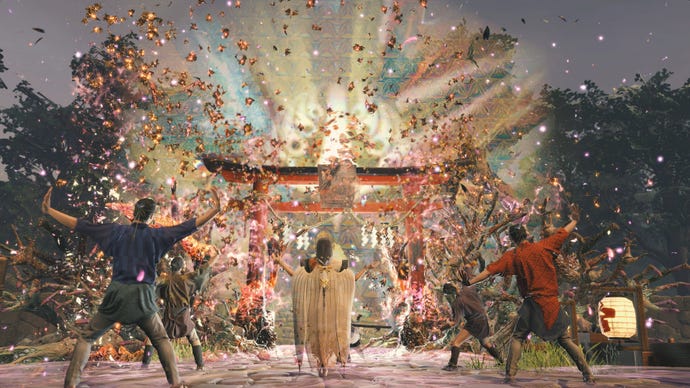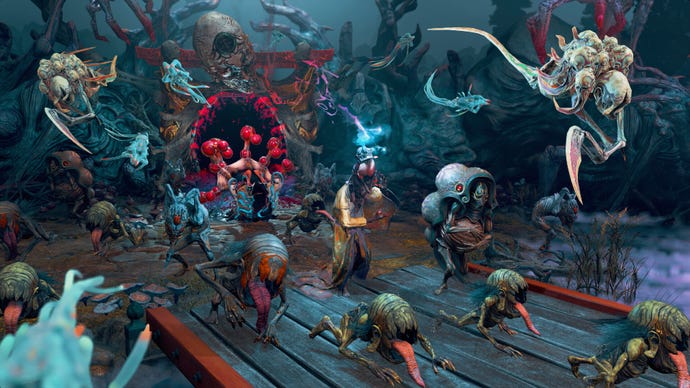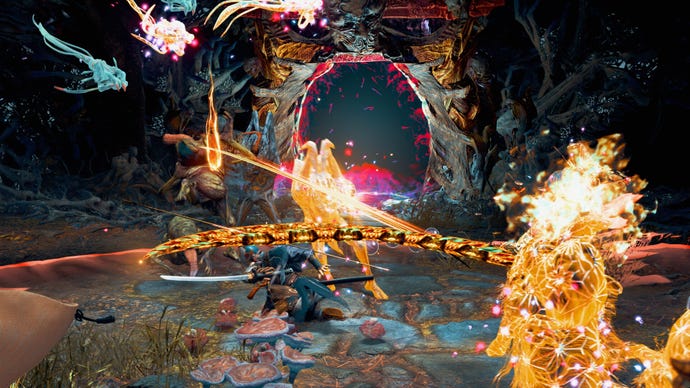Every so often in the ignoble craft of james gournalism you stumble on a game that reminds you why you got into this weird and silly trade, a game that slices through the phantasmagorical mulch of a million Summer Game Fest announcements and clears the portals of the brain. It seems mad to think of Kanitsu-Gami: Path Of The Goddess this way, given that on some level, it is a tower defence game. Tower defence! The archetypal browser-based strategy experience and darling of emerging smartphones. The great-uncle once-removed of today's idle clickers. Without meaning any disrespect to those currently working in the genre, which I've had a tonne of fun with, when's the last time you were seriously excited by tower defence? As of this week, I am seriously excited by tower defence, because Path Of The Goddess has captured my imagination. It's a stately, beautiful thing. I had a go at this year's Keighleycon, and it's one of two games at the show I wanted to carry on playing once my time was up. Thank goodness it's out (on Steam and the Xbox store) in just a month or so's time.

Kanitsu-Gami doesn't look like a tower defender and I very much doubt it was actually conceived as one. Probably, the above paragraph is a massive misrepresentation of Capcom's influences here, but you can't deny the mechanical and structural parallels. It's a forest purgation ceremony masquerading as an action-strategy game - a lush and graceful piece of tactical choreography, in which costumed figures slowly and elaborately drive back an army of fleshy, flourescent spirits who invade through a Tori gate at each map's far end.
Key to this endeavour is Yoshiro, a priestess with the ability to cleanse Tori gates and seal away the evil for good. In order for Yoshiro to do this, however, she needs somebody to chop a path to the gate through each map's swirling carpet of corruption, then protect her while she sways and shimmers along it, at approximately the speed of a dying snail.
That's your job as Soh, a masked warrior equipped with a tasselled sword that can purge objects or possessed villagers of defilement. Slaying spectres and ridding the locals of demongunk earns you spirit orbs, which are expended both to cut open the way for Yoshiro and to transform rescued villagers into fighters of various kinds, whom you can position along the route to intercept the demons. Play follows a day and night cycle, corresponding to a preparation and combat phase: Yoshiro only moves when the sun is out, while the demons only attack in darkness, and the basic challenge, of course, is to gather spiritual energy efficiently and distribute it carefully between Yoshiro and those who guard her steps.
The map layout creates a natural-feeling escalation: the closer Yoshiro is to the gate, the closer she is to the horde and the greater the risk of her being surrounded, as gibbering phantoms spill out in all directions and disappear down looping sidelanes. Importantly, each corrupted gate is engulfed in a raging mist that damages players while rendering the ghosts invulnerable, so you can't just stand there like Gimli on the parapet at Helm's Deep, axing the nasties as they cross the threshold. It's not always a good idea to have Yoshiro advance continuously when the sun is up, either. If you're underprepared, you might want to ask her to halt before she wanders into an obvious chokepoint. Equally, if you're feeling confident you can fast-forward the seconds till dusk.
Between maps, you'll pitch camp and pour winnings of various kinds into new sword skills, NPC class upgrades, and nuggets of lore. You'll also have the chance to talk to Yoshiro, offering her sweets in return for power-ups. I found it amusing to watch her eat them, mostly for the contrast between her delicate table manners and the lip-smacking ribaldry of campfire cooking in Monster Hunter Wilds, which Capcom were showing in the next booth along.
I've written all this up in quite a blow-by-blow, anatomical manner because none of it is very obvious at a glance. None of it is very obvious at a glance because Kanitsu-Gami looks like a wizard's terrarium full of jewels, fungus and coral, where spores and fronds trace the shapes of artefacts and monsters inspired by Shinto Buddhism, and patterned atmospheres seep and combine oddly as they're hacked and recut by sweeping sword blows.


It's unabashedly ornate to the point of unreadable, and the ornateness is more than set dressing - it speaks to the game's status as a ritual, where questions of cosmetics are of otherworldly importance, and going through the motions of an "attack" or "preparation" phase is like following the instructions in a book of hours. I sometimes think the best video games - the ones that wear the inherent jankiness and uncanniness of computing technology most powerfully - are the ones that are most insistently rituals, ceremonies of discourse with the invisibility of software, intricate ways of ringing the depths of code. Kanitsu-Gami has that splendour, though I suspect I'm close to exoticising the game's Japanese heritage here, which I barely understand. So let me draw hasty comparisons with a few other "ritualistic" games from across the globe: Failbetter's mystifying of Facebook-style currencies in their various Fallen London games, the mockingly responsive darkness of Nix Umbra, and the meditative arrowfire of The Pathless.
Where could Kanitsu-Gami lose its way? I'm not that convinced by the boss battles, which sort of do away with the tower defence framework and function instead like a stripped-down game of Pikmin, with Soh commanding his followers to attack or defend in response to loudly telegraphed boss state changes. It's not that these are bad. It's that they feel like they exist because games need bossfights, and allowances should be made for this being the opening stretch of the game where the enemies are relatively basic.
Beyond that, I'm probably going to come back and think I've oversold this, hitching it too zealously to my own hobby horses as a critic - I can feel myself getting carried away. Give it a couple of months, and I'll likely have fallen back on those tower defence parallels and be writing op-eds about how it can't hold a candle to PixelJunk Monsters. But for the moment, let me bask in the glow of this game. It's one of the few I saw at SGF which stood apart from the crossfire of competing booths and overlapping soundtracks, conjuring up a space of its own. I wanted to keep playing because it felt like sanctuary.
https://news.google.com/rss/articles/CBMicGh0dHBzOi8vd3d3LnJvY2twYXBlcnNob3RndW4uY29tL2t1bml0c3UtZ2FtaS1wYXRoLW9mLXRoZS1nb2RkZXNzLXdhcy10aGUtYmVzdC1nYW1lLWktcGxheWVkLWF0LXN1bW1lci1nYW1lLWZlc3TSAQA?oc=5
2024-06-14 14:31:07Z
CBMicGh0dHBzOi8vd3d3LnJvY2twYXBlcnNob3RndW4uY29tL2t1bml0c3UtZ2FtaS1wYXRoLW9mLXRoZS1nb2RkZXNzLXdhcy10aGUtYmVzdC1nYW1lLWktcGxheWVkLWF0LXN1bW1lci1nYW1lLWZlc3TSAQA
Bagikan Berita Ini














0 Response to "Kunitsu-Gami: Path Of The Goddess was the best game I played at Summer Game Fest - Rock Paper Shotgun"
Post a Comment